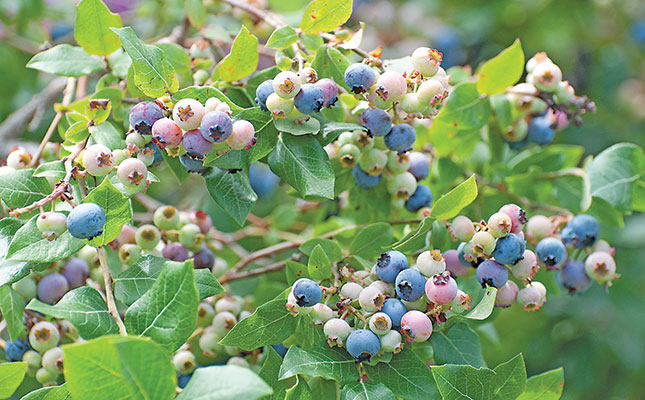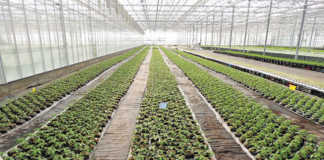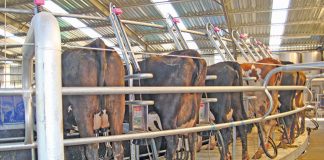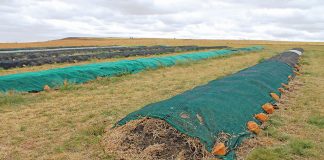
Photo: Flickr
Blueberries are a relatively new crop to South Africa, and with the frequent arrival of new varieties, finding the right recipe for optimal production is no easy matter.
At the same time, the price of blueberries is decreasing after hitting a peak two years ago, which means that farmers now need to make the most from every input and hectare to ensure their sustainability.
Unfortunately, their task is made far harder by the blueberry plant’s notorious inefficiency at absorbing calcium (Ca) and nitrogen (N), both of which are key elements required for a good fruit crop. Simply adding more of either nutrient doesn’t solve the problem. Instead, growers are advised to relook at application rates and methods, and the different forms of the elements.
Calcium
An adequate level of Ca improves both the quality and shelf life of blueberries. Low Ca levels, however, have far more to do with the crop than with fertiliser.
Dr David Marks, founder of UK-based Levity Crop Science, says that to understand why Ca applications are inefficient, farmers need to understand three basic rules on plant Ca metabolism: capacity, transport and absorption.
“Plants cannot store excess Ca as they can other nutrients, such as potassium. When the holding sites for Ca in cell walls are full, plants precipitate any extra Ca being absorbed. Often, plants that are deficient in fruit still precipitate Ca from their leaves.
“Calcium is not phloem-mobile, which means that it has to be transported via water through the plant. Water movement in a plant is governed by transpiration and moves in one direction: from roots to shoots. The areas of most water loss receive the greatest flow of water and therefore the biggest supply of Ca.
“In addition, the parts of the plants that have high levels of auxin [a hormone that regulates plant growth] absorb Ca easily, whereas those that are low in auxin absorb Ca sparingly, no matter how much is supplied. Ca levels are usually low in blueberries, due to the fruit being a low-auxin tissue and therefore a poor sink for Ca.”
Part of the absorption problem lies in the low auxin level of maturing berries. When the fruit is young and small (less than 2mm in diameter), the cells are dividing and the auxin level is high. But as the fruit starts to increase in size, cell division stops and the level of auxin begins to drop, leading to a limited capacity to absorb Ca.
According to Marks, applying Ca to the soil is not advisable, as it will bypass the fruit and be transported to the leaves, where transpiration is higher. But applying Ca directly to the fruit, apart from when very young, is also ill-advised, as it will not be absorbed due to the lack of auxin.
The solution lies in the correct timing and placement of Ca applications. Marks explains that fruit absorbs Ca best when it is applied between flowering and when the fruit is 2mm to 3mm in diameter. Foliar applications made during this period will be more effective than those made later in the season.
Nitrogen
The blueberry plant has both metabolic and physiological peculiarities that influence N use and its effect on growth habit. The plant has no root hairs, which limits water and nutrient uptake.
Instead, it has relatively large, shallow roots that serve mainly to anchor the plant and transport water, and finer feeder roots that absorb and transport nutrients. These feeder roots are short-lived, however, having a typical lifespan of less than 130 days.
This has a major impact on the crop. Since feeder roots die off relatively soon, it is of paramount importance to manage the crop for maximum root growth, as well as for continous root growth throughout the growing season.
“Secondly, and maybe less well understood, root hairs are the main site of production of the cytokinin hormone, which aids growth in plants. So the lack of root hairs in blueberries [significantly affects production of the crop].”
Nitrates
Another peculiarity is that the blueberry plant is less capable of processing nitrates than most other crops as it evolved in a low-nitrate environment. Technically speaking, it cannot efficiently utilise the nitrate reductase enzyme system that plants use to convert nitrate N into protein in order to grow.
Unfortunately, observes Marks, this makes the use of conventional fertilisers on a blueberry farm highly inefficient.
“This is why blueberry growers are often advised to avoid the use of nitrate fertiliser, and instead use ammonium or ureic N sources. But this doesn’t solve the problem either, as N is not environmentally stable. N uptake by crops bears little resemblance to N input, as it changes between application and uptake.
“In most cases, crops take up only 30% to 50% of the N applied. This is absorbed in the nitrate form, regardless of the form in which it is applied.
“Since blueberries [and other ericaceous plants, which prefer acidic soil] lack the capacity of other plants to process nitrate, leaf build-up is rapid following soil nitrogen application.
This leads to excessive auxin hormone production, which in turn encourages [more] vegetative growth, with less energy directed towards fruit formation, leading to a drop in yield.”
Marks explains that if auxin production is high compared with that of cytokinin, the plant allocates more growth to shoot development or vegetative growth. Conversely, if the plant has a better cytokinin-to-auxin ratio, there is more emphasis on reproductive growth, or fruit development.
The solution is therefore to use stabilised amine N, which can give blueberries the right balance of N for best growth and yield. A combination of the amine form of N (NH2), Ca, zinc (Zn) and amino acids, applied in small doses either via foliar spray or drip irrigation, changes the growth habit of the crop, resulting in shorter plants with more branching and better root development.
It also directs energy towards flowers and fruit rather than the classic nitrate-driven N response, which results in vegetative growth.
Improvement in fruit quality
In the 2019 season, a research project was carried out at Tzaneen Blueberries in Limpopo to test whether these Ca and N applications could improve production and fruit quality.
A combination of fertiliser and foliar feed products was applied on five-year-old blueberry plants of two cultivars, namely Snow Chaser and Jewel. Both are early-maturing, from August through to November, and the plants were grown on raised beds covered with weed mats, using a pressure-compensated drip irrigation system and a standard fertiliser programme.
The researchers applied foliar sprays by mist blower from as early as week three through to week 41, at two-to-six-week intervals, depending on the type of product and the crop and fruit development phases. Yield and fruit quality data were collected and analysed over the latter part of the year.
A combination of NH2, Ca, Zn and amino acids was found to boost the yield of Jewel by 22%, but produced no significant yield improvement in Snow Chaser. The combination did, however, increase the latter’s fruit firmness by 18% and the Brix level by 8,3%.
The researchers then developed a different foliar application, using NH2, magnesium (Mg), iron (Fe), manganese (Mn), Zn, copper (Cu) and boron (B), to increase the yield of Snow Chaser by 18,8%.
The fruit quality of both Snow Chaser and Jewel plants benefitted substantially from these foliar applications. In the former, fruit weight, firmness and Brix values were more than 4% better, and the number of undersized fruit 7,5% lower, than in plants of the control group.
The Jewel cultivar showed a different mix of results, with average fruit weight 3,3% higher, firmness 1,8% better, Brix levels 6,3% higher, and fruit size 3,5% greater, than fruit in the control group.
Marks explains that the NH2, Ca, Zn and amino acid combination has a positive impact on increasing reproductive growth, while the combination of NH2, Mg, Fe, Mn, Zn, Cu and B increases the plant’s tolerance to stress factors and disease.
“This is important for obtaining healthy plants that push out a higher percentage of berries,” he concludes.
Email David Marks at [email protected].











